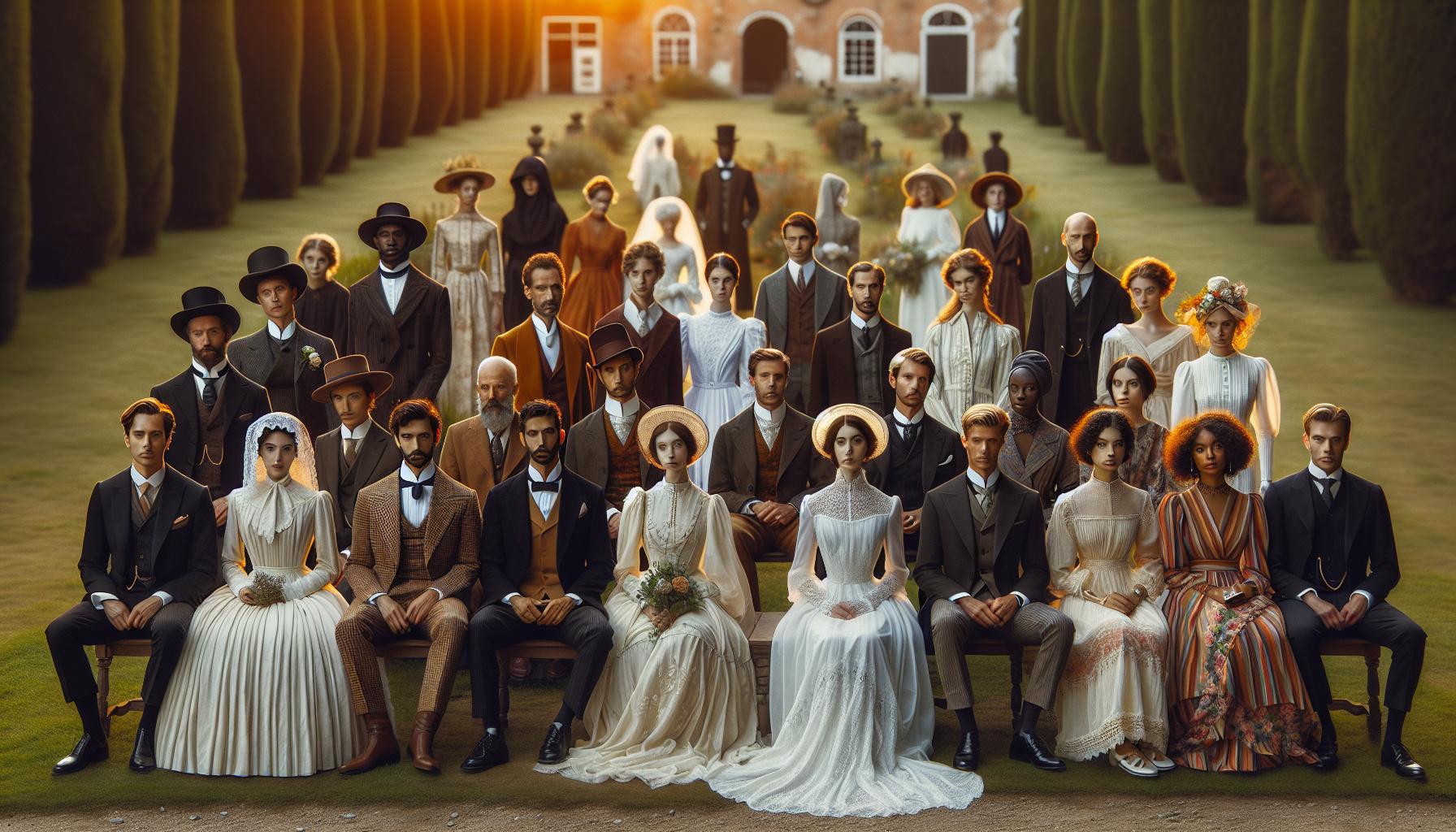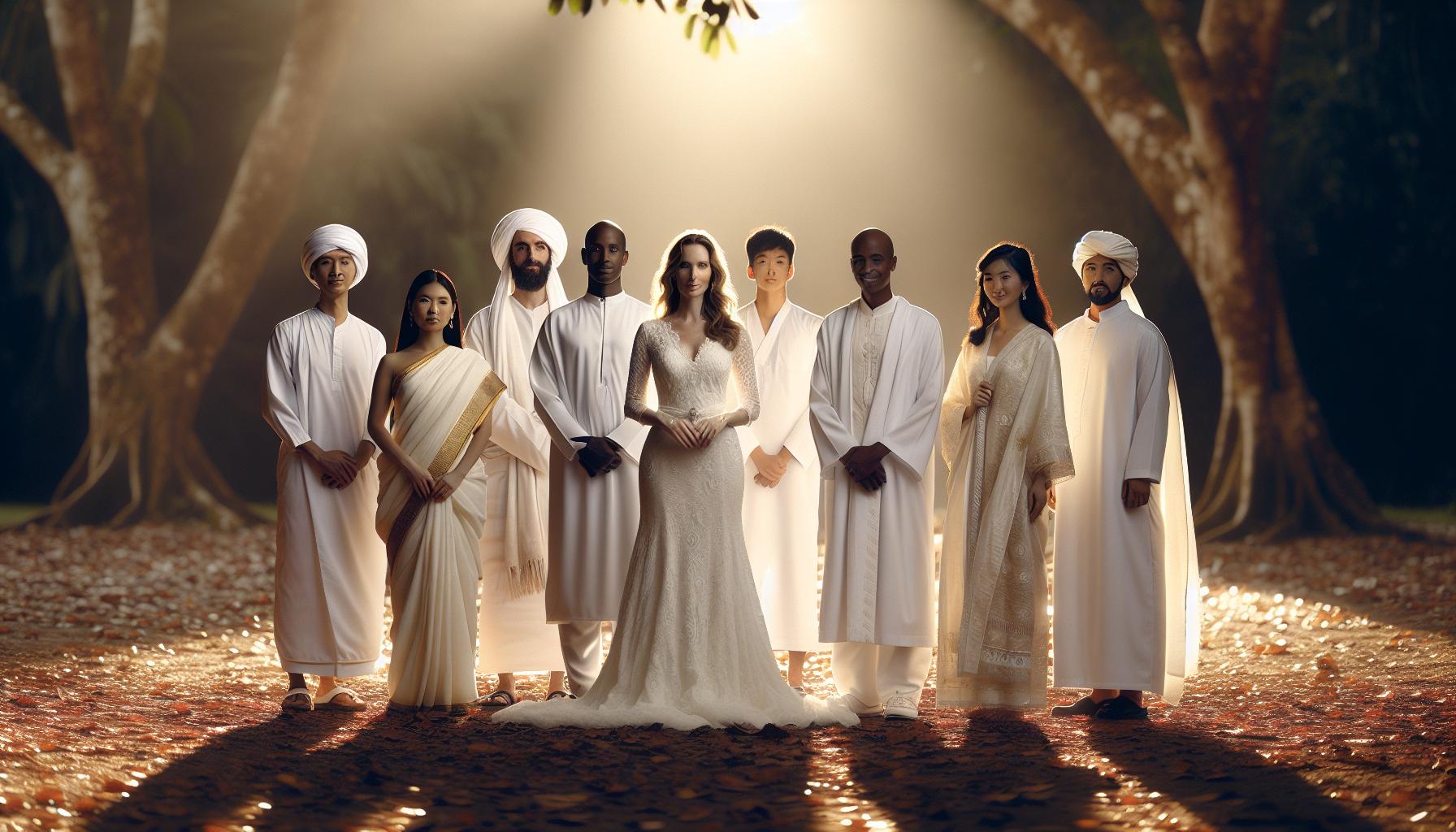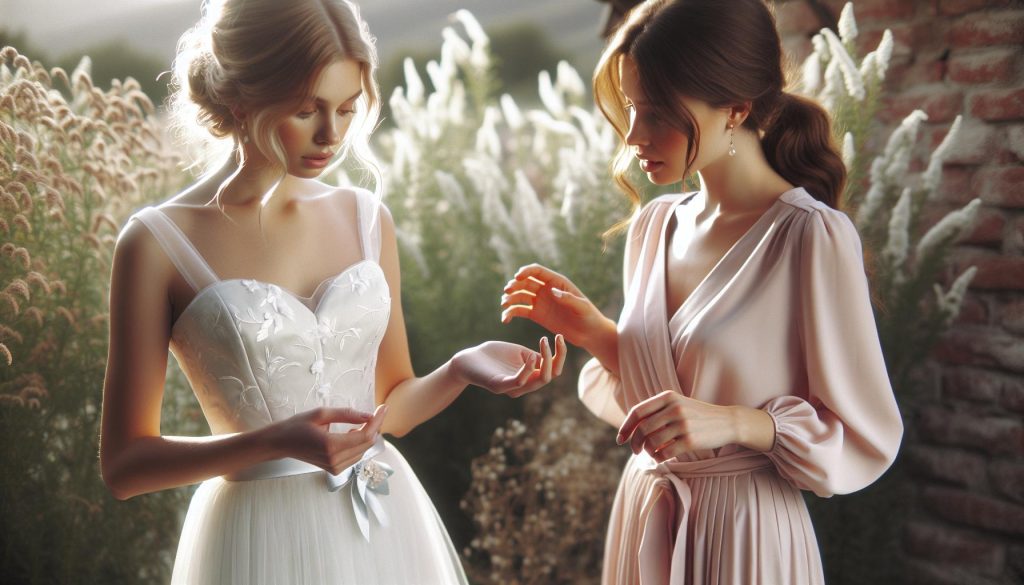Weddings are filled with cherished customs, and one of the most intriguing dilemmas often faced by guests is whether to don white attire. Traditionally reserved for the bride, the color white carries significant meaning in wedding culture. However, as wedding styles evolve, so do the rules surrounding this timeless question. Understanding the etiquette of wearing white is crucial, as it helps maintain respect for the couple’s special day while allowing guests to express themselves stylishly. You might be wondering: Can wearing white be acceptable, or is it a faux pas? In this article, we’ll explore the nuances of wedding attire, including when white might be appropriate and how to navigate potential sensitivities. Discovering the answers will empower you to make confident choices for your next wedding invitation, ensuring that you celebrate love while honoring the day’s traditions.
Should You Wear White to a Wedding? Understanding the Traditions
In the realm of wedding attire, the color white has long held a significant place, traditionally reserved for brides on their special day. Wearing white as a guest, however, can spark questions and concerns, as this choice can be seen as disrespectful or as drawing attention away from the bride. Understanding the traditions surrounding this color is crucial in navigating the delicate balance of etiquette at weddings.
Historically, the white wedding dress emerged in the 19th century, popularized by Queen Victoria when she married Prince Albert in a stunning gown of white lace. This choice was revolutionary at the time and has since evolved into a norm that symbolizes purity and new beginnings. Consequently, when attending a wedding, the common guideline is to avoid wearing white unless the invitation explicitly indicates otherwise. In some cultures, the significance of white may vary, leading to different customs regarding this hue. It is always wise to consult the couple or their close family if you desire to wear white, as personal preferences can differ significantly.
Beyond simply avoiding white, consider the overall atmosphere of the wedding. For some couples, particularly those with non-traditional themes or casual settings, wearing shades of off-white, cream, or even floral patterns that include white can be acceptable. Ultimately, what matters most is showing respect for the couple and their chosen symbols of love and unity. By remaining considerate of their wishes and the traditions tied to wedding attire, you can ensure that your outfit complements the joyous mood of the celebration without overshadowing the main event-the union of the couple.
The Evolution of Wedding Attire: From Past to Present

The journey of wedding attire reflects cultural shifts, societal norms, and personal expressions of love and commitment. In the past, weddings were often steeped in tradition, with brides typically wearing colors that held specific meaning-red in some cultures for luck and prosperity, or black in others to signify elegance and formality. However, the introduction of the white wedding dress during the reign of Queen Victoria in the 19th century marked a turning point, establishing a trend that has largely dominated Western nuptial customs. Her choice to don a white gown symbolized purity and innocence, transforming the perception of marriage and its attire profoundly.
Today, while white remains the predominant choice for brides in many Western societies, the landscape of wedding attire has diversified dramatically. The late 20th and early 21st centuries saw a growing acceptance of color and uniqueness in bridal fashion, allowing brides to select hues that best express their identities, such as blush pink, champagne, or even bold reds and blues. Moreover, cultural influences and global interconnectedness have led to a beautiful tapestry of traditions, where brides may opt for vibrant dresses reflecting their heritage alongside contemporary styles.
The evolution extends beyond the bride-wedding guests are now encouraged to embrace creativity in their attire while remaining respectful of traditional guidelines. Each wedding reflects the couple’s personality and vision, shining light on the need for guests to understand the significance of their attire choices, particularly when it comes to colors like white. As weddings increasingly incorporate themes and personal narratives, clarity in communication about dress codes becomes crucial. Couples can foster an inclusive environment by conveying their preferences on attire through invitations, making it easier for guests to navigate these traditions while expressing their own unique style.
Ultimately, the evolution of wedding attire emphasizes a blend of honoring tradition and celebrating individuality. As couples plan their special day, they can consider the richness of wedding attire history while allowing their love story and personal style to shine through, crafting a memorable celebration that respects the past while embracing the present.
Cultural Perspectives on Wearing White: A Global View

Throughout the world, the color white carries varying meanings and significance in the context of weddings. While Western traditions predominantly associate white with purity and innocence-stemming from Queen Victoria’s iconic choice in the 19th century-several cultures interpret the color differently, demonstrating the rich landscape of wedding customs. Understanding these diverse perspectives not only enlightens guests on wedding etiquette but also celebrates the myriad ways love is expressed globally.
In many East Asian cultures, for instance, white is traditionally linked to mourning and is often reserved for funerals rather than joyous occasions. In China, brides typically honor tradition by wearing red-the color of happiness, good fortune, and prosperity-rather than white. Similar customs are observed in other parts of Asia, where vibrant colors symbolize celebration and positivity. Moreover, in India, while brides may wear white during certain rituals, they predominantly don bright colors like red or pink, reflecting their cultural values and significance attached to such hues.
Conversely, in certain Western countries and among contemporary couples, the choice of attire has evolved to embrace personal expression over strict adherence to tradition. As couples curate their unique wedding experiences, some opt for colorful wedding gowns, while others incorporate white as part of a broader color palette. This evolution fosters a more inclusive environment where guests are encouraged to respect the couple’s vision while remaining mindful of cultural sensitivities.
As a guest navigating these diverse cultural landscapes, it is recommended to consider the couple’s heritage and the specific context of the event. Always consult the invitation for clues about dress code expectations and feel free to reach out to the couple for clarity if needed. Remember, the goal is to celebrate love in its many forms, and understanding the significance of color choices honors that spirit while allowing you to find joy in your fashion selections.
When is it Acceptable to Wear White as a Guest?
Wearing white to a wedding can be a nuanced decision for guests. A color synonymous with purity and celebration, white typically symbolizes the bride’s special day. However, there are contexts in which a guest wearing white can be perfectly acceptable and even welcomed. Understanding when and how to sport this color can help you navigate the delicate line between honoring the couple and making a personal style statement.
Firstly, it’s essential to consider the couple’s wishes. If the couple explicitly states on the invitation or in their wedding details that they welcome guests to wear white, feel free to embrace this hue confidently. Some couples might even incorporate a palette that includes white, encouraging guests to mirror their aesthetic. Additionally, certain wedding themes, such as beach or garden weddings, can make a lighter palette, including white, more suitable for guests.
When in doubt, reflect on the formality and the couple’s cultural context. In some cultures, wearing white may hold different meanings, thereby transforming the etiquette surrounding it. For instance, if the couple has a relaxed attitude toward attire or their cultural background embraces a more colorful spectrum, wearing white may not be seen as inappropriate. Moreover, attending an informal wedding or outdoor gathering can provide guests with greater leeway in attire choices, including shades of white or cream without overshadowing the bride.
Ultimately, maintaining open communication is key in making attire decisions. If unsure whether wearing white is suitable for the event, don’t hesitate to reach out to the couple or a close friend involved in the planning. This approach demonstrates your respect for their wishes while allowing you to express your style. Embracing these guidelines will help ensure that your choice is considerate and appropriate, letting you enjoy the celebration with positive energy and love.
The Role of the Bride: What Colors Are Reserved?
The delicate nature of wedding etiquette often leads to questions regarding what colors are appropriate for guests to wear in respect of the bride. Traditionally, the bride dons white or ivory, a color symbolizing purity and new beginnings, leaving a host of other shades available for guests. However, understanding color reservations can help ensure that everyone feels beautiful and comfortable while honoring the couple’s special day.
When planning an outfit, it’s essential to recognize that certain colors, especially white, cream, or even shades that closely resemble the bride’s gown, are generally reserved for her and her immediate bridal party. This unspoken rule serves to ensure that attention remains focused on the bride during this pivotal moment. While brides often choose to wear classic white, they may also opt for a softer blush, muted tones, or more vibrant colors that reflect their personality and wedding theme. In turn, these choices influence what guests may feel comfortable wearing.
In addition to white, other colors may also carry significant meanings depending on cultural contexts or personal beliefs. For example, red is traditionally reserved for brides in many Asian cultures, while purple could symbolize royalty or wealth. Therefore, understanding the cultural backgrounds and preferences of the couple can provide valuable insight into appropriate attire choices. If the bride has a specific color palette in mind, consulting that during your outfit selection is always a wise approach.
Embracing the idea that weddings are a celebration of love can pave the way for enjoyable attire choices for all involved. If you’re ever unsure whether a particular color is appropriate, reach out to the couple or consult the wedding invitation details for hints about dress code specifics. Through open dialogue and respect for the couple’s wishes, you can confidently select an outfit that reflects your style while honoring the bride’s special moment. Remember, a wedding is not just about individual expression; it’s also about celebrating the union of two hearts in love, so let that spirit guide your choices.
Fashion Tips for Non-Traditional Outfits at Weddings
Navigating the waters of wedding attire can be particularly exciting when it comes to making a statement beyond the traditional options. Embracing non-traditional outfits can infuse a sense of personality and flair into your look, showcasing your unique style while still being respectful of the occasion. For those yearning to break away from conventional dress codes, consider these fashion tips that celebrate individuality while maintaining elegance.
Understand the Event’s Atmosphere
It’s essential to align your non-traditional choice with the overall vibe of the wedding. Whether it’s a whimsical outdoor ceremony, a sophisticated urban affair, or a laid-back beach gathering, your outfit should resonate with the event’s tone. For instance, light, flowing fabrics with playful prints can complement a summer garden wedding, while romantic, dramatic pieces might better fit a candlelit evening ceremony.
Incorporate Personal Touches
Expressing your style through accessories or bold statements can transform an outfit beyond its basics. Consider pairing a classic jumpsuit with eye-catching jewelry or unique footwear that reflects your personality. Additionally, using colors that resonate with personal significance or charm can infuse warmth into your attire. Customizing your look with meaningful tokens-be it a family heirloom necklace or a vibrant scarf-can also be a beautiful way to pay homage to loved ones while standing out.
| Outfit Type | Styling Tips |
|---|---|
| Jumpsuit | Pair with statement heels and bold jewelry for a modern look. |
| Maxi Dress | Opt for unconventional patterns or colors, and layer with a chic jacket. |
| Culottes | Style with a fitted top and a belt to enhance your silhouette. |
| Tailored Suit | Add a vibrant shirt or tie to showcase your unique flair. |
Mind the Color Palette
While you may want to shimmer in bold colors and prints, it’s essential to be mindful of the bride’s chosen palette-especially to avoid overshadowing the bride herself. Vibrant hues can be beautiful, but ensure they don’t clash or dive too closely into the territory of the bride’s selected shades. If in doubt, leaning towards earth tones or softer hues can maintain a respectful ambiance while still allowing you to express personal style.
By thoughtfully selecting your outfit and embracing elements of creativity, you can celebrate love while feeling confident in your unique fashion choices. Every wedding should be a joyful occasion, and your attire can reflect that spirit, making memories not just of the couple’s union, but of your celebration of it as well.
The Impact of Season and Venue on Wedding Attire Choices
When it comes to choosing the perfect outfit for a wedding, understanding the influence of season and venue is essential. These elements can significantly affect not only your attire but also your comfort throughout the day. A wedding held in a sun-soaked beach setting during the summer will necessitate a vastly different approach than one taking place in a cozy, candlelit hall during winter.
Seasonal Considerations
Weddings in the summer invite lighter fabrics and vibrant colors that complement the sunny ambiance. Lightweight materials like chiffon, linen, or cotton can keep guests cool, while playful prints and pastel shades mirror the joyful atmosphere. Conversely, winter weddings often encourage richer fabrics, such as velvet or silk, paired with darker, more opulent colors. This seasonal shift not only enhances the aesthetic but also ensures comfort according to the temperature.
Venue Vibes
The type and location of the venue are equally crucial in determining your outfit. Outdoor ceremonies amidst nature may call for relaxed, flowing dresses or tailored suits that allow movement and ease-think romantic maxi dresses or sharp, breathable blazers. Meanwhile, formal venues may demand evening wear with more structure; consider elegant cocktail dresses or tailored suits paired with sophisticated accessories to match the grand setting.
It’s also wise to think about the details of the venue, such as whether the event is taking place on grass, sand, or a polished floor. A relaxed beach wedding may inspire flat sandals, while an upscale ballroom often calls for heels. Paying attention to these nuances will not only enhance your style but also ensure that you look and feel your best, ready to celebrate with joyful abandon.
By thoughtfully considering both the season and venue, you can curate an outfit that not only honors the couple’s special day but also reflects your personal style, helping you revel in the love and happiness surrounding the event.
Navigating Family and Friend Expectations Regarding Attire
Navigating the expectations of family and friends regarding wedding attire can be both an exhilarating and challenging part of preparing for a special day. The excitement surrounding weddings often brings about a flurry of opinions, particularly on what to wear, which can lead to confusion. The key to successfully maneuvering through these expectations is open communication and a willingness to embrace the bride and groom’s vision while expressing your own individual style.
Families often have longstanding traditions and beliefs about wedding attire that can influence guests’ choices. For instance, some families might expect that guests should avoid certain colors, particularly white, as it is traditionally reserved for the bride. To ensure you are respecting these traditions while also feeling comfortable and stylish, start by having candid conversations with the couple or the family members involved in the planning. Ask about any specific dress code they envision and whether there are colors they would like guests to avoid. This not only shows your respect for their wishes but also provides clarity about how to dress appropriately.
It’s also important to consider the broader social dynamics at play. Friends may have differing opinions on what attire is acceptable, influenced by their own experiences or cultural backgrounds. Thus, seeking consensus among friends can help minimize outfit mishaps. Sharing outfit inspirations, whether through text or social media, can foster creativity and camaraderie, ensuring that everyone feels included in the celebration process. Additionally, emphasize personal expression within respectful boundaries. For instance, if you prefer a bold color, look for styles that incorporate that color in tasteful ways that won’t upstage the bride.
Ultimately, the goal is to blend your personal style with the expectations of the couple and their families. As you navigate these social nuances, remember to focus on the joy of the occasion. Embrace the spirit of celebration, knowing that every guest’s unique attire contributes to the collective beauty and happiness of the day. By fostering open communication, considering family traditions, and encouraging inclusivity among friends, you will find a harmonious balance that honors both the couple’s wishes and your own personal expression.
Dress Code Details: How to Interpret Wedding Invitations
Understanding how to decipher wedding invitations can transform the often overwhelming process of choosing your attire into a joyous and straightforward task. Each element of the invitation is a clue to the formality of the event and, consequently, the appropriateness of your outfit choices. This pivotal document is more than just a date and location; it encapsulates the couple’s vision for their day, showcasing their style, preferences, and, most importantly, the expected dress code.
Begin by closely examining the wording of the invitation. Formal events often feature traditional phrases such as “black tie,” “formal,” or “cocktail attire.” Each of these terms carries specific implications about your outfit:
- Black Tie: A tuxedo for men and a formal gown or elegant cocktail dress for women.
- Formal: Similar to black tie, but can be slightly less rigid; think elegant floor-length dresses and suits.
- Cocktail Attire: This invites more creativity-think knee-length or midi dresses, and well-tailored suits.
- Casual: In this case, smart casual is often the aim. For women, this might mean a sundress or dressy pants; for men, tailored shorts or chinos with a nice shirt.
Another pivotal aspect is the theme and location of the wedding, which can provide insights into what may be deemed appropriate. A beach wedding, for example, calls for lighter fabrics and breathable materials, while a ceremony at a grand church may lean toward more traditional attire. If the invitation includes specific guidelines about colors or styles-like stating that guests should avoid wearing white-it is crucial to respect these requests to honor the couple’s special day.
Ultimately, interpreting wedding invitations goes beyond the written instructions; it embodies the couple’s personality and the type of event they envision. Feeling confident in your attire starts with understanding the expectations, allowing you to blend seamlessly into the celebration while expressing your own unique style. By paying careful attention to these details, you can ensure that your outfit not only aligns with the formalities but also radiates joy and respect for the couple’s momentous occasion.
Personalizing Your Wedding Look: Unique Color Choices
Weddings are the perfect opportunity to showcase your personal style while respecting the couple’s vision for their celebration. Choosing unique colors for your outfit can not only help you stand out but also elevate the overall look you present as a guest. As you consider options, think about colors that complement both the wedding’s theme and the season, while also resonating with your personal taste. For instance, pastels are a fabulous choice for spring, while rich jewel tones work beautifully for fall events.
The key to personalizing your wedding look lies in understanding the couple’s preferences and any suggested color palettes mentioned in their invitation or wedding details. If the invitation indicates a specific color scheme, such as navy and blush, consider incorporating these hues into your outfit through accessories like a scarf, belt, or even shoes. This subtle nod shows thoughtfulness and aligns your look with the couple’s aesthetic.
When selecting colors, also consider the significance they may hold. For example, in some cultures, red symbolizes celebration and good luck, making it an invigorating choice for weddings. Vibrant colors like emerald green or royal blue can evoke a sense of elegance, making you look polished while still being true to yourself. A wrap dress in a deep plum or an outfit with gold accents can equally blend tradition and modern flair, allowing for both comfort and style on the dance floor.
Lastly, remember that each wedding has its own decor and ambiance; the venue, whether it’s a tranquil garden or a grand ballroom, plays a significant role in dictating appropriate colors. A destination wedding might inspire lighter, tropical hues, while a rustic barn event calls for earthier tones. By harmonizing your look with the event’s surroundings, you create a cohesive, stylish presence that fits perfectly within the joyful tapestry that is a wedding celebration.
What to Do if You’re Not Sure About Your Outfit?
When faced with uncertainty about what to wear to a wedding, it’s essential to remember that you’re not alone; many guests share this dilemma. The key lies in gathering information, drawing inspiration, and ensuring that your choices honor the couple’s special day. Start with the invitation, as it often contains valuable insights into the expected dress code or theme. If phrases like “black tie,” “cocktail,” or “casual” are mentioned, these provide a strong foundation upon which to build your outfit.
If the invitation lacks clarity, reaching out to the couple or a member of the wedding party is a respectful step. Sending a quick message to ask for guidance on acceptable attire demonstrates your eagerness to comply with their wishes. Also, consider the venue; a beach wedding likely calls for lighter fabrics and colors than a formal indoor setting. An excellent way to explore outfit ideas is by browsing wedding photo galleries or fashion blogs that align with the couple’s wedding style, providing a plethora of options and inspiration tailored to various themes and settings.
As you prepare, assessing your current wardrobe can be a practical approach. Look for pieces you already own that may align with the dress code or can be easily accessorized to fit. Combining existing items with new accessories or shoes can help you create a striking look without overspending. Furthermore, embrace the charm of personal touches by selecting accents, such as jewelry or a scarf, that echo the wedding’s color palette or seasonal nuances. Keep in mind that while the occasion is celebratory, your comfort remains paramount; you want to feel as good as you look as you enjoy the festivities.
Lastly, if you still find yourself puzzled about your outfit, consider consulting a trusted friend who has an eye for fashion or visiting a clothing store known for its attentive staff. Engaging with those who understand current trends can lend clarity and ensure that you put together an ensemble that leaves you feeling confident and festive while honoring the couple’s joyous celebration.
Final Thoughts on Wedding Guest Attire Etiquette
In the realm of wedding celebrations, attire etiquette can often feel like a maze of unspoken rules and cultural nuances. As a guest, understanding the intricacies of what to wear is essential not only for feeling confident but also for honoring the couple and their special day. Whether you’re pondering whether to don white, or striving to blend style with tradition, navigating these choices can enhance the joy of the occasion and contribute positively to the overall vibe of the wedding.
When considering your outfit, remember that the couple’s preferences take precedence. It can be helpful to reflect on the couple’s style and the wedding theme. For example, a modern couple may embrace a more relaxed approach to attires, such as allowing guests to wear colors or even patterns that resonate with their personal flair, while a traditional ceremony may call for more structured, conservative choices. It’s wise to regard the invitation as your primary guide-pay attention to the specified dress code, and don’t hesitate to reach out to other guests or the couple for clarification on more ambiguous directives.
Being mindful of the venue is equally crucial. Different settings often dictate dress appropriateness; a rustic barn wedding might invite casual chic, while a gala reception would warrant formal elegance. Seasons play a role, too-spring and summer weddings generally allow for lighter fabrics and brighter palettes, whereas fall and winter might favor richer tones and heavier materials. Additionally, engaging with the wedding party and observing how they present themselves can help set the tone for your attire.
Ultimately, the goal is to feel comfortable and confident while maintaining respect for the couple’s celebration. Showcasing personal style through well-considered choices can add to the festivity, ensuring you’re in sync with the spirit of the event. So as you prepare for that joyous day, embrace the excitement of choosing your attire, knowing that your thoughtful approach will enhance not just your experience, but support a beautiful occasion that will be etched in memory for years to come.
Faq
Q: Is it ever appropriate to wear white to a wedding as a guest?
A: Yes, wearing white to a wedding can be acceptable in certain situations, such as when the couple specifies a color scheme that includes white or if the ceremony is less traditional. Always check for any dress code guidelines provided by the couple or wedding invitations to ensure appropriateness.
Q: What are the cultural meanings of wearing white at a wedding?
A: In many Western cultures, white symbolizes purity and new beginnings, traditionally worn by brides. However, in other cultures, white can have different meanings, such as mourning in some Asian cultures. It’s important to understand the cultural context of the wedding you’re attending.
Q: Can the bride’s wishes about white attire be overruled?
A: While personal preferences vary, it’s considered polite to honor the bride’s wishes regarding attire. If she explicitly requests guests to avoid white, it’s best to choose another color to respect her special day.
Q: What should you do if you feel uncomfortable wearing white to a wedding?
A: If you feel uneasy about wearing white, opt for a different color that still aligns with the wedding’s theme or dress code. Your comfort is important, and selecting a flattering option in line with the event’s formality can make you feel more at ease.
Q: Are there any exceptions to the rule of not wearing white?
A: Exceptions can include themed weddings where white is part of the attire, or if the invitation suggests that guests should wear white. In such cases, confirm with the couple if you’re unsure.
Q: How can I personalize my outfit while still adhering to wedding attire etiquette?
A: Personalizing your wedding outfit can be achieved through accessories, unique colors, or styles that reflect your personality. Choose statement pieces or prints that align with the wedding’s theme while avoiding colors that might clash with the bride’s attire.
Q: What colors should be avoided when attending a wedding?
A: Apart from white, it’s advisable to avoid black in many cultures, as it is associated with mourning. Additionally, colors that match the wedding party attire may also be off-limits to prevent confusion and ensure the couple stands out on their special day.
Q: How can I confidently choose my wedding outfit if I’m unsure about etiquette rules?
A: Research the couple’s style and the formality of the wedding. Consider consulting with friends or checking sections of online articles about wedding attire etiquette for guidance. If in doubt, you could always reach out directly to the couple for their preferences.
Wrapping Up
As you navigate the nuances of wedding attire, remember that understanding etiquette around wearing white is just one aspect of making your special day perfect. Whether you’re a guest or the couple themselves, honoring tradition while expressing personal style is key. Don’t hesitate to explore our articles on wedding invitation etiquette and attire selection tips for different wedding styles.
If you’re ready to dive deeper into your wedding planning journey, check out our comprehensive guides that offer step-by-step advice on everything from vendor coordination to ceremony traditions. Your dream wedding is within reach, and we’re here to support you every step of the way. Join our newsletter for ongoing tips and updates, and share your thoughts in the comments below-your insights could help fellow couples! Embrace the excitement and let’s keep the celebration going!











